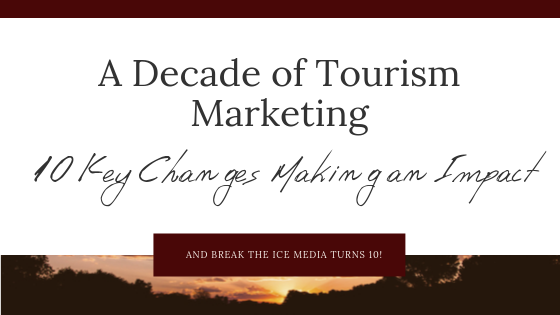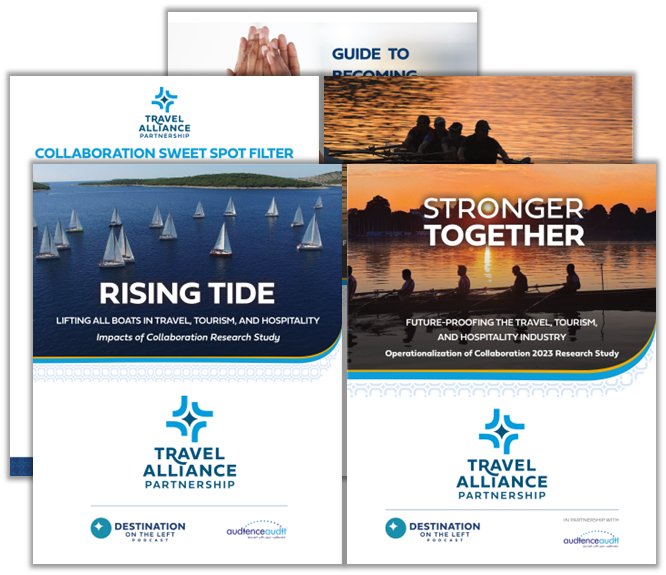A Decade of Tourism Marketing – 10 Key Changes Making an Impact
And Break the Ice Media turns 10!
It has been a decade of tourism marketing! The official date of incorporation for Break the Ice Media is October 14, 2009 which makes October officially our “birthday month”. As the marketing and tourism industries have changed, we have evolved right along with them. When we started our company, we were focused on integrating social media, which was basically Facebook at that time, with public relations to help small businesses reach new customers. Small businesses and the communities that they support are at the heart of what our company is built on. We have learned and grown alongside our clients and I wanted to share ten key changes that we believe have made an impact on tourism marketing.

Digital marketing is the new standard in marketing
Ten years ago, tourism brands and businesses in the industry were trying to figure out what to do about Facebook and Twitter. One article in PCWorld, “2009: the year of the Social Network” described it like this:
“It looks like 2009 will be known as the year that social networking went mainstream,” said Dan Olds, an analyst with the Gabriel Consulting Group. “This was the year when Mom, Dad, and even Grandma found Facebook and Twitter, and used them to make the Web a part of their lives — often for the first time.”
Flashforward 10 years and there are countless social networks with more than 4.4 billion users. More people are online than ever before and we have changed the way we search, recommend, shop and buy products, services and travel. Digital is no longer an added tactic in a strategic marketing plan, it is now central.
Greater focus on measurement and attribution
Return on Marketing Investment (ROMI) is not new. The importance of measuring results from a campaign or marketing program has always been on the minds of marketers, business owners and destination marketers. But with the advent of digital marketing and technology, there are more ways than ever to measure a campaign’s success. Tools like Google Analytics, Facebook, email marketing platforms and others offer resources for tracking and understanding campaign effectiveness. New tools and technologies such as Adara’s destination marketing cloud and Arrivalist help marketers understand how marketing campaigns convert target audiences from awareness to action.
Expanding tourism product
We are seeing more destinations developing tourism product. From explosive growth in the craft beverage industry (think wine, beer, spirts and cider) to new hotel developments, to new tour products, to new ways to experience a destination (think AirB&B), we have been on an upward curve of tourism product development. This development brings new opportunities; new reasons for visitors to come to a destination and greater reach of tourism markets as this development hits second- and third-tier markets.
On the other hand, this growth has also provided some challenges as attractions and tourism businesses have seen declines in visitation because there are more places for people to be. This is especially noticeable in smaller markets where tourism product development may be outpacing visitation growth.
The insider trend
As more product and information becomes available online, visitors have been increasingly turning to the DMO for help and guidance. DMOs have found creative ways to deliver insider information to the public, basically sharing the inside secrets about where the locals go. We have seen this through focused blogs, newsletters, Instagram takeovers, video series and more.
Rise of the Influencer
Visitors and consumers are looking for ways to help them navigate the many choices available to them and Influencers have been able to fill that gap. Influencers come in many forms, from micro to macro, serving niche audiences from families to girlfriends to LGBTQ and covering topics from fashion to consumer goods to travel. With different needs and expectations than traditional media, reaching and working with influencers successfully has become an art in itself. To help our team and our clients approach this market, we wrote an ebook offering every tool in our toolbox.
Less focus on the press release
In 2009, one of the key tools in our PR toolbox was the press release. We used it as our cornerstone piece of content and then re-purposed it into social posts, email marketing and follow-up pitches. That is not the case anymore. One can no longer rely solely on a press release to do the trick. Most PR placements that we receive are accomplished through a strategic PR plan. That includes direct pitching, desk side visits, FAM tours, Influencer visits, media shows, reactive PR to inquiries from resources like HARO and occasionally a press release.
Changing local media landscape
As local newspaper, TV and radio outlets race to adapt to a digital world, we have seen a shift in focus, high turnover in journalists and strengthening of niche publications. National corporations have been buying local media outlets and centralizing reporting. Many times, those reporters are no longer in the local market. If they are, there are fewer of them and they are stretched thin. This has caused us to change our approach to local media, including keeping up with the changes as many news reporters leave. We work to pitch those local niche publications in a similar way that we approach national travel media. We have found success in helping overstretched reporters through release style outreach that they can repurpose into a story with little editing.
Marketing automation
Marketing automation is no longer just a B2B tactic. Today it allows marketers to automate tasks that guide individuals through the visitor journey. Effective digital campaigns use automation to increase conversions through on-going nurturing campaigns that lead a visitor from consideration to the decision to visit. Tools like Salesforce, Hubspot, Infusionsoft, and Sharpspring have made this tool more accessible and easier to learn and use.
Mobile websites are now table stakes
Most visitors’ first impression of a business is its website. More and more often, they are browsing those sites through their mobile devices, which can include phones, tablets and e-readers, rather than a desktop. That means it is no longer acceptable to have a website that does not adapt for mobile viewing. Many website designs are starting with a mobile first approach to ensure clients don’t lose potential business before they’ve even explored the site.
Freestyle trips in the group market
The groups and motorcoach market is stronger than ever. On a recent episode of Destination on the Left, a tour operator told me that these are not the golden years of travel, but the platinum years. Tour operators have been seeing steady growth over the last decade. What has changed is the types of groups that are traveling, their interests and how they want experiences. Group tours are starting to add in more “free time” and more “choice,” allowing individuals the ability to customize portions of their trip such as meals and excursions. This freestyle approach was taken right from the cruise industry where you see more choice for passengers than ever before.
The next 10 years
It has been a fun decade of growth, learning and evolution. We are excited about the next decade of tourism marketing and are already watching some trends that we believe are going to make a huge impact on the future. A few of those include:
- AI
- Data science
- Increased international visitors to U.S. 2nd and 3rd tier markets
- The evolving role of the DMO
- Accessible tourism
- Overtourism
But more on those trends later.
Author
Related Posts
10 Must-Listen Podcasts for Travel, Tourism & Hospitality Professionals
I’ve had the joy of hosting Destination on the Left—an award-winning podcast spotlighting the travel, tourism, and hospitality industry—since 2016. My team and I believe…
How Tourism Brand Ambassadors Elevate Your Destination Story
In today’s world, it can seem like everything in marketing and sales has changed. But the one thing that hasn’t changed is the value of...
